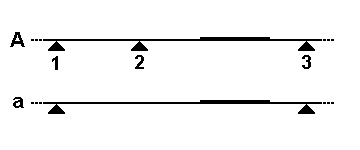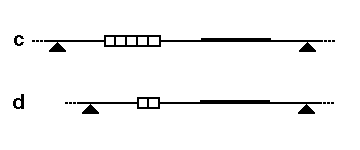Restriction fragment length polymorphism
In molecular biology, restriction fragment length polymorphism (RFLP) is a technique that exploits variations in homologous DNA sequences, known as polymorphisms, populations, or species or to pinpoint the locations of genes within a sequence. The term may refer to a polymorphism itself, as detected through the differing locations of restriction enzyme sites, or to a related laboratory technique by which such differences can be illustrated. In RFLP analysis, a DNA sample is digested into fragments by one or more restriction enzymes, and the resulting restriction fragments are then separated by gel electrophoresis according to their size.
RFLP analysis is now largely obsolete due to the emergence of inexpensive
RFLP analysis
The basic technique for the detection of RFLPs involves fragmenting a sample of DNA with the application of a



Examples
There are two common mechanisms by which the size of a particular restriction fragment can vary. In the first schematic, a small segment of the genome is being detected by a DNA probe (thicker line). In allele A, the genome is cleaved by a restriction enzyme at three nearby sites (triangles), but only the rightmost fragment will be detected by the probe. In allele a, restriction site 2 has been lost by a mutation, so the probe now detects the larger fused fragment running from sites 1 to 3. The second diagram shows how this fragment size variation would look on a Southern blot, and how each allele (two per individual) might be inherited in members of a family.
In the third schematic, the probe and restriction enzyme are chosen to detect a region of the genome that includes a
Applications
Analysis of RFLP variation in genomes was formerly a vital tool in genome mapping and genetic disease analysis. If researchers were trying to initially determine the chromosomal location of a particular disease gene, they would analyze the DNA of members of a family afflicted by the disease, and look for RFLP alleles that show a similar pattern of inheritance as that of the disease (see
RFLP analysis was also the basis for early methods of
Alternatives
The technique for RFLP analysis is, however, slow and cumbersome. It requires a large amount of sample DNA, and the combined process of probe labeling, DNA fragmentation, electrophoresis, blotting, hybridization, washing, and
RFLP is still used in marker-assisted selection. Terminal restriction fragment length polymorphism (TRFLP or sometimes T-RFLP) is a technique initially developed for characterizing bacterial communities in mixed-species samples. The technique has also been applied to other groups including soil fungi. TRFLP works by PCR amplification of DNA using primer pairs that have been labeled with fluorescent tags. The PCR products are then digested using RFLP enzymes and the resulting patterns visualized using a DNA sequencer. The results are analyzed either by simply counting and comparing bands or peaks in the TRFLP profile, or by matching bands from one or more TRFLP runs to a database of known species. A number of different software tools have been developed to automate the process of band matching, comparison and data basing of TRFLP profiles.[2]
The technique is similar in some aspects to
The sequence changes directly involved with an RFLP can also be analyzed more quickly by PCR. Amplification can be directed across the altered restriction site, and the products digested with the restriction enzyme. This method has been called
